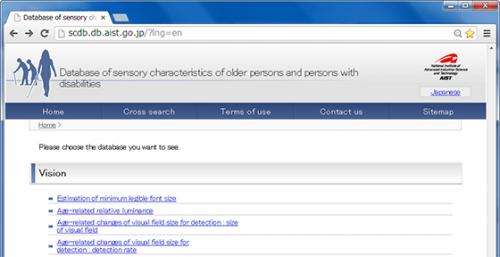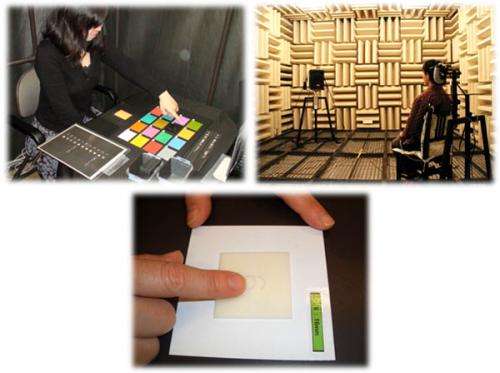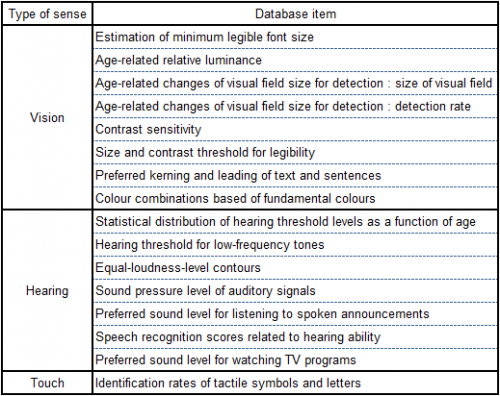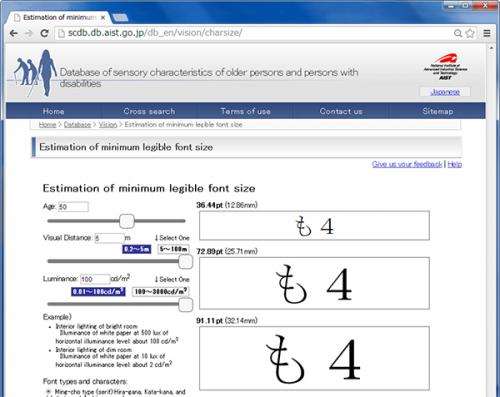Database offers graphic display of sensory characteristics of vision, hearing, and touch

Researchers with AIST have constructed a "Database of sensory characteristics of older persons and persons with disabilities" (Fig. 1).
The database displays the sensory characteristics of vision, hearing, and touch measured by AIST from a target group with a total number of more than 3,000 people, corresponding to search conditions such as age and types of disability. Since these characteristics data were adopted as Japanese Industrial Standards (JISs) "Guidelines for older persons and persons with disabilities", the database has a function of displaying graphically JIS contents described by equations and tables.
Conventionally, there has been a tendency to design daily-life products, environments, services, etc. for young healthy people. From now on, referring to the database by product designers will make it easier to design products fitting various types of people including older persons and persons with disabilities, and the creation of easy, comfortable products and environments is expected to move forward by the "accessible design".
Japanese and English versions of the database have been released to the public on the Web from August 19, 2013. Anybody can access and use the data free of charge as long as they comply with the conditions of use.
Until now, daily-life products, environments, and services have commonly been designed and developed for young healthy people. However, in recent years with the remarkable increase in the number of older persons and the increase in consideration for persons with disabilities, development of products that enable everybody to use products safely and construction of living environment that enables everybody to live comfortably, regardless of age or whether or not they have disabilities, are strongly in demand.
In order for product designers and such to understand the inconvenience and difficulties experienced by older persons and persons with disabilities in daily living, it is required to measure changes in the characteristics of senses (vision, hearing, touch etc.) resulting from aging and disabilities scientifically and to present them to the designers objectively. However, efforts to measure the state of aging of healthy people and extent of disabilities systematically have been rare. In general, older persons and persons with disabilities differ much individually. Therefore, data of several tens to several hundreds people are required to clarify the overall picture of sensory characteristics and this is not easy to implement from cost and labor perspectives.
Furthermore, it is impossible to finalize the design specifications of products optimized for both older persons and persons with disabilities simply by collecting measurement data. Design technology that covers the changes due to aging and disabilities effectively based on data and knowledge is required. The development of new design methods (accessible-design technology) that can finalize the optimum specifications based on the data of older persons and persons with disabilities has been awaited by the product designers.

For more than 15 years, AIST has been measured the various kinds of sensory characteristics such as vision, hearing, and touch of older persons and persons with disabilities (Fig. 2), and the total number of the measured people has exceeded 3,000.
Furthermore, it has developed the accessible-design technology by comparing the measured data with those of young healthy persons. The technology has been standardized as JISs "Guidelines for older persons and persons with disabilities" and utilized widely in the society. Furthermore, some of the standards have become a standard of the International Organization for Standardization and used internationally.
Therefore, by releasing data for which social demand is high among the collected data of sensory characteristics and providing the associated utility tools for JISs "Guidelines for older persons and persons with disabilities", AIST has pursued to realize quick and easy creation of products and environments that fit various types of people, including older persons and persons with disabilities.
Some of the data in the database were collected in cooperation with the National Institute of Technology and Evaluation.
In this study, by measuring various aspects of vision, hearing, and touch such as easiness to see, hear, and recognize (Fig. 2), the researchers have clarified changes in sensory characteristics due to aging and the influence of disabilities on the characteristics. For these measurements, they owed a lot to the cooperation of individuals, from various generations and with different types and extents of disabilities such as low vision and color-vision deficiency. These measured sensory characteristics data were recompiled into a searchable form in the developed database, and the database can display the data as easy-to-see graphics.
With the database, the user can freely select the relevant items from 16 data items (Table 1), classified into the senses of vision, hearing, and touch. Users identify the data items, and select or input numbers indicating age and gender of the target, and measurement conditions. The data corresponding to the input conditions can be retrieved and the measurement results will be displayed as graphs and detailed numerical values.

As an example, a database display of "legible font size" is shown in Fig. 3. When age, visual distance, luminance, and character font are selected on the left side of the display, the minimum legible font size (minimum size of characters that can be recognized) and easy-to-read font size corresponding to those conditions will be displayed on the right side.
The estimation of legible font size is based on the method standardized in JIS S 0032 "Estimation of minimum legible size for a Japanese single character". It is not necessarily easy to obtain the legible size from the document, as it requires the calculation using tables and equations. When utilizing the tools provided with the database, any estimation result such as legible font size can be obtained without reading the detailed tables and solving the equations.
Since the inquiry conditions can be changed by using a slider, the minimum legible font size can be seen by changing the various age and conditions continuously. Furthermore, since the estimation results are displayed as not only numerically (in pt and mm) but the actual size of character, the user can understand the difference in ease of reading depending on the conditions intuitively by seeing it through the user's own eyes.

Since the measurement data that forms the basis of the developed database is extremely large, AIST cannot release all data on the Web. Those interested in obtaining more detailed data (product designers of companies etc.) can consult with the researchers regarding the release of more data using the contact information described in the database.
In addition to the contact information, the database has a questionnaire page in order to hear opinions and requests from users. Data released at this time is limited to 16 items, but the researchers plan further expansion such as the refinement of unreleased data and the addition of new items, with reference to the feedback from users through questionnaires etc.
More information: scdb.db.aist.go.jp















